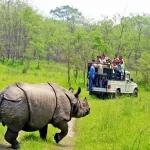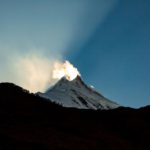Table of Contents
Conquering Everest Base Camp: Choosing the Perfect Trekking Season
Everest Base Camp, the gateway to the world’s tallest mountain, beckons trekkers with its awe-inspiring scenery and challenging trails. But before you embark on this unforgettable adventure, choosing the best time for your Everest Base Camp Trek is crucial. The Himalayan weather varies significantly throughout the year, impacting everything from comfort levels to visibility. Here’s a breakdown of each season’s pros and cons to help you make an informed decision:
Spring (March-May):
- Pros: This is widely considered the best time for Everest Base Camp Trek due to pleasant weather with clear skies. Rhododendrons in bloom paint the landscape with vibrant colors, and conditions are ideal for acclimatization to high altitudes.
- Cons: Spring coincides with peak season, so expect larger crowds on the trails. There’s also a possibility of occasional haze in late April and May that can obstruct mountain views.
Autumn (September-November):
- Pros: Autumn offers another excellent window for your Everest Base Camp Trek. Crystal-clear skies present stunning mountain vistas. You’ll encounter fewer crowds compared to spring, and temperatures are comfortable for trekking.
- Cons: Nights can be colder in autumn, and occasional snow flurries are a possibility.
Beyond the Peak Seasons:
- Summer (June-August): The monsoon season brings heavy rainfall, making trails muddy and slippery. This is not the ideal time for trekking.
- Winter (December-February): Winter offers a unique experience for seasoned trekkers with minimal crowds. However, extremely cold temperatures and potential snowfall can block mountain passes.

Choosing Your Ideal Everest Base Camp Trek Season:
- For Clear Skies and Pleasant Temperatures: Aim for mid-September to November (autumn) or March-April (spring).
- For Fewer Crowds: Consider the shoulder seasons of early March or late November. Be prepared for slightly less predictable weather conditions during these times.
- For Solitude (and Frigid Temperatures): Winter offers a unique experience for experienced trekkers equipped with proper cold-weather gear.
Remember:
- Book Well in Advance: Permits and teahouse accommodation fill up quickly, especially during peak seasons.
- Consider Your Fitness Level: High-altitude trekking demands good physical condition. Train accordingly beforehand.
- Be Prepared for the Unexpected: The Himalayas can be unpredictable. Pack for a variety of weather conditions.
With careful planning and the right season, your Everest Base Camp trek will be an unforgettable adventure. Start your Everest journey today!
Bonus Tip: For an even more unique experience, explore alternative treks like Gokyo Lakes Trek, offering breathtaking views alongside Everest Base Camp.
Essential Considerations for Your Everest Base Camp Trek
The Everest Base Camp Trek is an epic adventure that pushes you both physically and mentally. To ensure a safe and enjoyable experience, here are some key things to consider before you embark on your journey:

Physical Fitness:
- Training: This trek is not for the faint of heart. It involves several days of walking at high altitudes, so getting into good physical condition beforehand is crucial. Start a training program that includes cardiovascular exercise and strength training several months in advance.
- Altitude Acclimatization: Altitude sickness is a serious concern on the Everest Base Camp Trek. The gradual ascent and designated acclimatization days are essential for allowing your body to adjust to the decreasing oxygen levels. Be patient and listen to your body during these times.
Planning and Logistics:
- Permits and TIMS Card: You’ll need a special permit to trek in Everest National Park. This can be obtained through a registered trekking agency in Nepal. Additionally, you’ll need a Trekkers’ Information Management System (TIMS) card, which can be acquired in Kathmandu.
- Choosing a Season: The best time to trek Everest Base Camp is during the shoulder seasons of spring (March-April) or autumn (September-November) when you’ll encounter pleasant weather and fewer crowds compared to peak season.
- Booking: Tea house accommodation, especially during peak seasons, fills up quickly. Book your trek well in advance, particularly if you have specific preferences.
- Travel Insurance: Ensure your travel insurance covers medical emergencies, helicopter evacuation (in case of altitude sickness), and trip cancellation.
Gear and Equipment:
- Clothing: Pack layers of warm, breathable clothing suitable for changing weather conditions. This includes a good quality waterproof jacket, trekking pants, thermals, fleece layers, and a hat.
- Footwear: Sturdy, well-broken-in trekking boots with good ankle support are essential.
- Backpack: Choose a comfortable backpack with a capacity of 40-50 liters to carry your essentials.
- Sleeping bag: A good quality sleeping bag rated for cold temperatures (down to -10°C) is necessary.
- Trekking Poles: Poles will help with balance and stability on uneven terrain, especially during descents.
- Other Essentials: Don’t forget a headlamp, water bottle, water purification tablets, sunscreen, sunglasses, a hat, a first-aid kit, and personal medications.
Additional Considerations:
- Mental Preparation: The trek can be challenging, both physically and mentally. Be prepared for long days of walking, unpredictable weather, and potential setbacks. A positive attitude and strong determination will go a long way.
- Respecting the Local Culture: You’ll be trekking through the homeland of the Sherpa people. Be respectful of their culture and traditions. Learn a few basic Nepali phrases and dress modestly when visiting monasteries and gompas.
- Environmental Responsibility: Trekking in the Himalayas requires practicing responsible tourism. Pack out all your trash and avoid using polluting items like single-use plastics.
By carefully considering these factors and planning meticulously, you’ll be well on your way to conquering the Everest Base Camp Trek and creating an unforgettable Himalayan adventure.

Everest Base Camp Trek FAQs
Here are some frequently asked questions (FAQs) about the Everest Base Camp Trek:
Difficulty:
- Q: How difficult is the Everest Base Camp Trek?
- A: The Everest Base Camp Trek is considered a moderate to challenging trek. It’s not technical, but the high altitude makes it demanding. Good physical fitness and proper acclimatization are crucial.
Timing:
- Q: What is the best time to do the Everest Base Camp Trek?
- A: The best time to trek Everest Base Camp is during the shoulder seasons (March-April or September-November). These months offer pleasant weather and fewer crowds compared to peak season (May and October).
Permits and Costs:
- Q: What permits do I need for the Everest Base Camp Trek?
- A: You’ll need a special permit to trek in Everest National Park, obtainable through a registered trekking agency in Nepal. You’ll also need a Trekkers’ Information Management System (TIMS) card, acquired in Kathmandu.
- Q: How much does the Everest Base Camp Trek cost?
- A: Costs vary depending on the duration of your trek, chosen route, group size, and amenities. Generally, expect to pay around $2,000 to $3,500 USD for a guided trek, which includes permits, accommodation, meals, and guide services.
Training:
- Q: How do I train for the Everest Base Card Trek?
- A: Focus on cardiovascular exercise (hiking, running, swimming) and strength training to build endurance and muscle strength in your legs. Start training several months in advance.
Altitude Sickness:
- Q: What is altitude sickness, and how can I avoid it?
- A: Altitude sickness is a common condition caused by rapid ascent to high altitudes. Symptoms include headaches, nausea, dizziness, and shortness of breath. Ascend gradually and take designated acclimatization days to allow your body to adjust.
Accommodation:
- Q: Where will I be staying during the trek?
- A: You’ll primarily stay in teahouses, which are lodges offering basic accommodation and meals along the trekking route.
Safety:
- Q: Is the Everest Base Camp Trek safe?
- A: Generally, the Everest Base Camp Trek is safe with proper planning and precautions. Choosing a reputable trekking agency with experienced guides is essential. Be aware of altitude sickness and listen to your body.
I hope this FAQ section addresses some of your common concerns.








